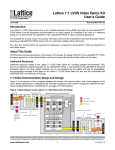Download User`s Manual - Vivid Engineering
Transcript
C L R - 111 C A M E R A L I N K T M R E P E AT E R User’s Manual Document # 200563, Rev 1.0, 5/8/2006 Vivid Engineering 418 Boston Turnpike #104 • Shrewsbury, MA 01545 Phone 508.842.0165 • Fax 508.842.8930 Table of Contents 1. Introduction 1 1.1. Overview 1 1.2. Features 2 1.3. Functional Description 3 1.3.1. Mode Switch 4 1.4. Typical Applications 7 1.4.1. Standard Application 7 1.4.2. 30 Meter Application 8 1.4.3. Base-Only Application 9 1.5. Specifications 10 2. Interface 11 2.1. Front Panel Connections 11 2.2. Rear Panel Connections 12 2.3. Video Connector Signals 12 2.4. Cable Shield Grounding 13 3. Mechanical 16 3.1. Dimensions 16 3.2. External Power Supply 17 4. Revision History 18 1. Introduction 1.1. Overview The CLR-111 Camera LinkTM1 Repeater supports applications requiring separation between camera and frame grabber in excess of the maximum Camera LinkTM cable length (10 meters). One Camera LinkTM cable pair connects the camera to the CLR-111, and a second cable pair connects the CLR-111 to the frame grabber. This solution provides a 20 meter reach between camera and frame grabber using standard 10m Camera LinkTM cables. Up-to three repeaters may be cascaded to support greater distances. The CLR-111 incorporates high-speed 85 MHz interfaces and supports all Camera LinkTM configurations (base/medium/full). The CLR-111 also supports 80-bit extended applications. The CLR-111 is housed in a sturdy, compact aluminum enclosure and is well suited for industrial environments. Vivid Engineering PWR MODE Camera Link Repeater FULL CAMERA CLR-111 BASE CAMERA The Camera LinkTM interface standard enables the interoperability of cameras and frame grabbers, regardless of vendor. The Automated Imaging Association (AIA) sponsors the Camera LinkTM program including the oversight Camera Link Committee, the self-certification program, and the product registry. The Camera LinkTM specification may be downloaded from the AIA website, found at www.machinevisiononline.org 1 Camera LinkTM is a trademark of the Automated Imaging Association 1 1.2. Features • Doubles max distance between camera and frame grabber • Uses standard Camera LinkTM cables (not included) • Supports all Camera LinkTM configurations (base/medium/full) • High-speed 85 MHz interface chipset • Mode switch to optimize timing characteristics for different cameras, cables, and frame grabbers • Supports 80-bit extended Camera Link applications • Up-to three CLR-111’s may be cascaded, supporting a 40m reach • Flow-through connector positioning (front-panel camera connectors, rear-panel frame grabber connectors) • Sturdy, compact aluminum enclosure w/ mounting flange • 3-year warrantee • Cost-effective solution • Well suited for industrial and OEM applications 2 1.3. Functional Description A block diagram of the CLR-111 is provided in Figure 1-1. The CLR-111 regenerates the entire “full” configuration signal set as defined in the Camera Link Specification. The regenerated signals may then be transmitted an additional distance up-to 10 meters over standard Camera LinkTM cables. "Full" Video Data Channel Link Receiver Data "Med" Video Data Channel Link Receiver Data "Base" Video Data Channel Link Receiver Data Camera Control LVDS Transmitter Serial Comm Link Clock Clock Clock Channel Link Transmitter "Full" Video Data Channel Link Transmitter "Med" Video Data Channel Link Transmitter "Base" Video Data LVDS Receiver Camera Control LVDS Rcvr LVDS Xmtr LVDS Xmtr LVDS Rcvr CLR-111 Camera LinkTM Repeater Figure 1-1: CLR-111 Block Diagram 3 Serial Comm Link To Camera LinkTM Frame Grabber To Camera LinkTM Camera The CLR-111 incorporates the connectors, signals, pinout, and chipset in compliance with the Camera LinkTM specification. The CLR-111 regenerates all the “full” configuration signals, consisting of video data, camera control, and serial communications. The video interfaces utilize high-speed (85 MHz) Channel Link devices. The CLR-111 connects all signals between the Channel Link receivers and their corresponding transmitter devices. This arrangement supports the 80-bit (i.e. 10 8-bit taps) extended Camera Link configuration used with some high-performance cameras. The CLR-111 incorporates a mode switch to optimize timing characteristics for use with different cameras, cables, and frame grabbers. The mode switch determines which internal clock signals are used for the medium and full Channel Link transmitters. The mode switch is described further in the next section. The CLR-111 is powered by an external wall plug-in power supply (optional). 1.3.1. Mode Switch The CLR-111 incorporates a mode switch to optimize its timing characteristics for use with different cameras, cables, and frame grabbers. This feature addresses the interfacing problems sometimes encountered in Camera Link systems, especially in medium and full applications using higher clock frequencies and/or long cables. As shown in Figure 1-1, the CLR-111 incorporates three Channel Link receiver/transmitter device pairs (base, medium, full). Each Channel Link receiver chip deserializes multiplexed video data received from the camera, outputting 28-bit parallel data and a reference clock. The standard approach is to send the 28-bit data and reference clock from each Channel Link receiver to its corresponding transmitter. This configuration recommended for most applications and is shown in Figure 1-2. "Full" Video Data Channel Link Receiver Data "Med" Video Data Channel Link Receiver Data "Base" Video Data Channel Link Receiver Data Clock Clock Clock Channel Link Transmitter "Full" Video Data Channel Link Transmitter "Med" Video Data Channel Link Transmitter "Base" Video Data Figure 1-2: Standard Clock Mode, Switch = 00 Some frame grabbers have difficulty handling the slight timing differences (skew) between the base, medium, and full data groups it receives. The situation may 4 become worse with longer cable lengths, higher pixel clock frequencies, and when repeaters are used. The CLR-111 features two additional clock modes to reduce skew at the frame grabber. The Base Clock Mode, shown in Figure 1-3, resynchronizes the base, medium, and full transmitters to the clock received at the base receiver. The result of this resynchronization is a reduction in skew between base, medium, and full data groups at the frame grabber. This configuration also matches well with frame grabber hardware implementations that do not utilize the reference clocks received at the medium and full receivers. "Full" Video Data Channel Link Receiver Data Channel Link Transmitter "Full" Video Data "Med" Video Data Channel Link Receiver Data Channel Link Transmitter "Med" Video Data "Base" Video Data Channel Link Receiver Data Channel Link Transmitter "Base" Video Data Clock Figure 1-3: Base Clock Mode, Switch = 01 The Base/Medium Clock Mode, shown in Figure 1-4, resynchronizes the medium and full transmitters to the clock received at the medium receiver. The result of this resynchronization is a reduction in skew between medium and full data groups at the frame grabber. This configuration also matches well with frame grabber hardware implementations that do not utilize the reference clock received at the full receiver. "Full" Video Data Channel Link Receiver Data Channel Link Transmitter "Full" Video Data "Med" Video Data Channel Link Receiver Data Channel Link Transmitter "Med" Video Data "Base" Video Data Channel Link Receiver Data Channel Link Transmitter "Base" Video Data Clock Clock Figure 1-4: Base/Medium Clock Mode, Switch = 10 5 The Mode Switch positions are summarized in Figure 1-5. 1 2 00 01 10 11 Clock Mode - Standard Clock Mode (base/medium/full) - Base Clock Mode - Base/Medium Clock Mode - Test mode, reserved 1 = "up" switch position 0 = "down" switch position Figure 1-5: Mode Switch Positions 6 1.4. Typical Applications 1.4.1. Standard Application A typical CLR-111 application is shown in Figure 1-6. A Camera LinkTM “medium” or “full” configuration camera is connected to the CLR-111 via a pair of standard 10m Camera LinkTM cables. A second 10m Camera LinkTM cable pair is then connected from the CLR-111 to a Camera LinkTM frame grabber. This provides a 20 meter reach between camera and frame grabber CLR-111 Camera LinkTM Repeater Camera LinkTM Frame Grabber Vivid Engineering PWR Camera LinkTM Camera MODE Camera Link Repeater FULL CAMERA CLR-111 BASE CAMERA Standard 10m Camera LinkTM Cables 20 Meter Reach Figure 1-6: CLR-111 Standard Application 7 1.4.2. 30 Meter Application Figure 1-7 shows an application in which two CLR-111’s and standard cables are cascaded to provide a 30 meter separation between “medium” or “full” camera and frame grabber. In this example, a 30 meter reach is achieved using two CLR-111’s and six standard 10m Camera LinkTM cables. CLR-111 Camera LinkTM Repeater Camera LinkTM Frame Grabber Vivid Engineering CLR-111 Camera LinkTM Repeater Vivid Engineering PWR Camera LinkTM Camera MODE Camera Link Repeater FULL CAMERA PWR MODE Camera Link Repeater FULL CAMERA CLR-111 BASE CAMERA CLR-111 BASE CAMERA Standard 10m Camera LinkTM Cables 30 Meter Reach Figure 1-7: CLR-111 30m Application 8 1.4.3. Base-Only Application A base-only CLR-111 application is shown in Figure 1-8. A Camera LinkTM “base” configuration camera is connected to the CLR-111 via a standard 10m Camera LinkTM cables. A second 10m Camera LinkTM cable is then connected from the CLR-111 to a Camera LinkTM frame grabber. This provides a 20 meter reach between camera and frame grabber. CLR-111 Camera LinkTM Repeater Camera LinkTM Frame Grabber Vivid Engineering PWR Camera LinkTM Camera MODE Camera Link Repeater FULL CAMERA CLR-111 BASE CAMERA Standard 10m Camera LinkTM Cables 20 Meter Reach Figure 1-8: CLR-111 Base-Only Application 9 1.5. Specifications Table 1-1: CLR-111 Specifications Feature Specification Video Interfaces Camera Link Spec “full” configuration Video Connectors 26-pin MDR type Frequency Range 20 - 85 MHz Chipset National Semi. DS90CR287 / DS90CR288A Power Supply Optional US/Europe Transformer w/ Outlet Plug Set Power Jack 2.1 x 5.5 mm, center-positive Power Requirements 5-7 VDC, 270 mA (typical) Cabinet Dimensions 5.28” (L) x 1.18” (H) 6.12” (D) Weight 13 oz Operating Temperature Range 0 to 50° C Storage Temperature Range -25 to 75° C Relative Humidity 0 to 90%, non-condensing 10 2. Interface 2.1. Front Panel Connections The CLR-111 Camera LinkTM Repeater front panel is shown in Figure 2-1. The front panel contains two 26-pin MDR video connectors; one for connecting to the camera “base” connector, and one for connecting to the camera “medium/full” connector. The MDR-26 connectors are 3M devices as specified in the Camera Link Spec. Figure 2-2 identifies the MDR-26 pin positions. The front panel also contains a 2-position mode switch described in Section 1.3.1 and an LED power indicator. Vivid Engineering PWR MODE Camera Link Repeater FULL CAMERA CLR-111 BASE CAMERA Figure 2-1: CLR-111 Front Panel pin 13 pin 1 pin 26 pin 14 Figure 2-2: MDR-26 Connector Pin Positions 11 2.2. Rear Panel Connections The CLR-111 Camera LinkTM Repeater rear panel is shown in Figure 2-3. The rear panel contains two 26-pin MDR video connectors; one for connecting to the frame grabber “base” connector, and one for connecting to the frame grabber “medium/full” connector. The MDR-26 connectors are 3M devices as specified in the Camera Link Spec. The rear panel also contains the DC power jack. DC power jack accepts 5-7 volts DC. Polarity is center-positive. The MDR-26 connectors are 3M devices as specified in the Camera Link Spec. BASE GRABBER FULL GRABBER 5-7 VDC Figure 2-3: CLR-111 Rear Panel 2.3. Video Connector Signals The MDR-26 video connector signal assignments comply with the Camera LinkTM “full” configuration, providing compatibility with all Camera Link cameras and frame grabbers (base, medium, and full). The camera connector signal assignments correspond to the frame grabber interface defined in the Camera Link Specification. Conversely, the frame grabber connector assignments are as defined for the camera interface in the Camera Link Specification. This arrangement provides compatibility with standard Camera LinkTM cables. Tables 2-1 and 2-2 identify the signal assignments for the CLR-111 “Base” and “Medium/Full” MDR-26 video connectors, respectively. 12 2.4. Cable Shield Grounding Camera and frame grabber cable “outer” shields are connected to the CLR-111 aluminum case. The case is isolated from the CLR-111 circuitry and the cable “inner” shields. The frame grabber cable “inner” shield connects to circuit digital ground, maintaining signal reference levels between the CLR-111 and the frame grabber. The Camera LinkTM Specification recommends that a provision be incorporated into frame grabbers that enable the inner shields be tied to digital ground either directly, or through a parallel R/C network. In CLR-111, the camera connector represents the Camera LinkTM frame grabber interface. To incorporate this flexibility, the CLR-111 ties the inner shields from the camera connector to digital ground through 0-ohm resistors. If necessary, the 0ohm resistors may be replaced with a parallel RC network. 13 Table 2-1: MDR-26 “Base” Connector Assignments Camera Link Signal Name Camera Connector Pin # (frame grabber pinout) Frame Grabber Connectors Pin # (camera pinout) Signal Direction Inner shield 1 1 N/A Inner shield 14 14 N/A X0- 25 2 CAM → FG X0+ 12 15 CAM → FG X1- 24 3 CAM → FG X1+ 11 16 CAM → FG X2- 23 4 CAM → FG X2+ 10 17 CAM → FG Xclk- 22 5 CAM → FG Xclk+ 9 18 CAM → FG X3- 21 6 CAM → FG X3+ 8 19 CAM → FG SerTC+ 20 7 FG → CAM SerTC- 7 20 FG → CAM SerTFG- 19 8 CAM → FG SerTFG+ 6 21 CAM → FG CC1- 18 9 FG → CAM CC1+ 5 22 FG → CAM CC2+ 17 10 FG → CAM CC2- 4 23 FG → CAM CC3- 16 11 FG → CAM CC3+ 3 24 FG → CAM CC4+ 15 12 FG → CAM CC4- 2 25 FG → CAM Inner shield 13 13 N/A Inner shield 26 26 N/A “FG” = Frame Grabber, “CAM” = Camera 14 Table 2-2: MDR-26 “Medium/Full” Connector Assignments Camera Link Signal Name Camera Connector Pin # (frame grabber pinout) Frame Grabber Connectors Pin # (camera pinout) Signal Direction Inner shield 1 1 N/A Inner shield 14 14 N/A Y0- 25 2 CAM → FG Y0+ 12 15 CAM → FG Y1- 24 3 CAM → FG Y1+ 11 16 CAM → FG Y2- 23 4 CAM → FG Y2+ 10 17 CAM → FG Yclk- 22 5 CAM → FG Yclk+ 9 18 CAM → FG Y3- 21 6 CAM → FG Y3+ 8 19 CAM → FG 100 Ω 20 7 N/A terminated 7 20 N/A Z0- 19 8 CAM → FG Z0+ 6 21 CAM → FG Z1- 18 9 CAM → FG Z1+ 5 22 CAM → FG Z2- 17 10 CAM → FG Z2+ 4 23 CAM → FG Zclk- 16 11 CAM → FG Zclk+ 3 24 CAM → FG Z3- 15 12 CAM → FG Z3+ 2 25 CAM → FG Inner shield 13 13 N/A Inner shield 26 26 N/A “FG” = Frame Grabber, “CAM” = Camera 15 3. Mechanical 3.1. Dimensions The CLR-111 Camera LinkTM Repeater cabinet dimensions are shown in Figure 3-1. PWR MODE FULL CAMERA CLR-111 BASE CAMERA m ou nt in g Camera Link Repeater 6. 12 "( in cl ud in g 1.18" Vivid Engineering fla ng e) The CLR-111 is housed in a sturdy aluminum enclosure. The body is extruded aluminum, with detachable front and rear endplates. The enclosure incorporates a mounting flange. The flange contains four predrilled holes (0.15” diameter) for convenient equipment mounting. A mounting hole template drawing is provided in Figure 3-2. 5.28" Figure 3-1: CLR-111 Cabinet Dimensions 16 5.62" 6.12" (Rear) Mounting Holes (4): 0.15" dia (Front ) 5.00" 5.28" Figure 3-2: Mounting Hole Template 3.2. External Power Supply The CLR-111 is powered by 5-7 VDC and incorporates a standard 2.1 x 5.5 mm DC power jack. Power plug polarity is center-positive. The CLR-111 includes a multi-nation wall-mount power supply that handles a wide power range (90-264 VAC, 47-63 Hz) and comes with a set of outlet plugs suitable for most countries (US, Europe, UK, etc). The CLR-111 may also be purchased without the power supply. The CLR-111 is protected by internal resettable fuses. 17 4. Revision History Table 5-1: CLR-111 User’s Manual Revision History Document ID # Date 200563-1.0 5/8/2006 Changes Initial release of manual 18




































